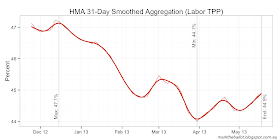Julian King at Pottinger has developed a Bayesian model to predict the election outcome based on past election outcomes and the current polls. His conclusion: the Coalition has a 93.6% chance of winning the election, the ALP has a 1.9% chance of winning the election, and there is a 4.5% chance of a hung parliament.
In the Guardian, Simon Jackman (also drawing on Bayesian statistics) observes "I expect some narrowing to be more likely than the Coalition improving on 55-45 TPP. But bottom line: Labor just can’t get to an election winning position from here."
Update
Kevin Bonham has looked at the above analyses. While he agrees with their conclusion, it is not because a five point move in the polls is uncommon. They have happened many times in past; just under different circumstances.
Paul Davis also had a look at these analyses. His assessment is more critical.




















































